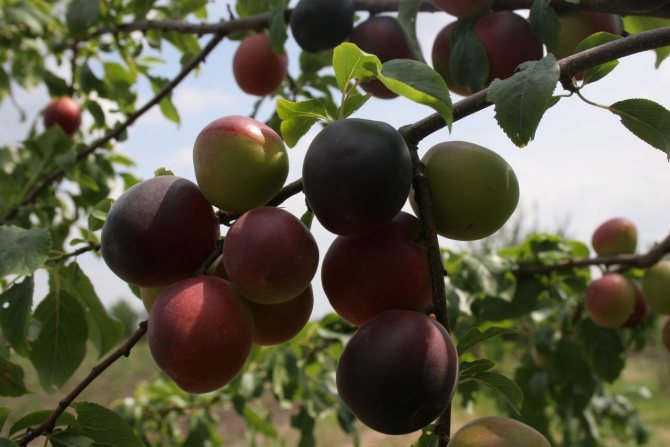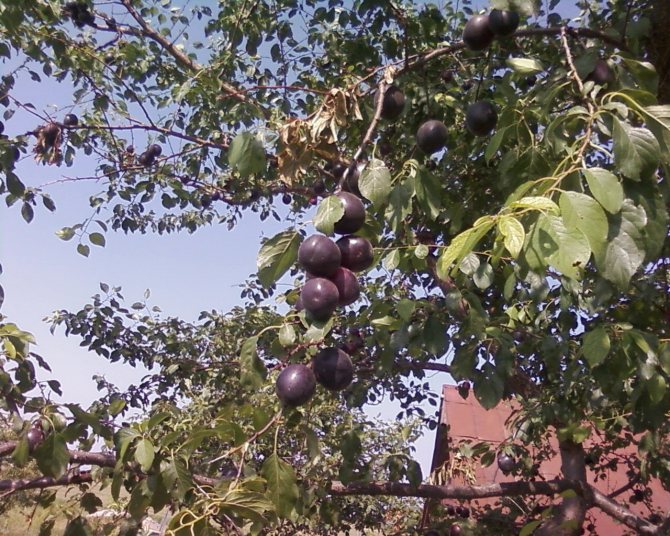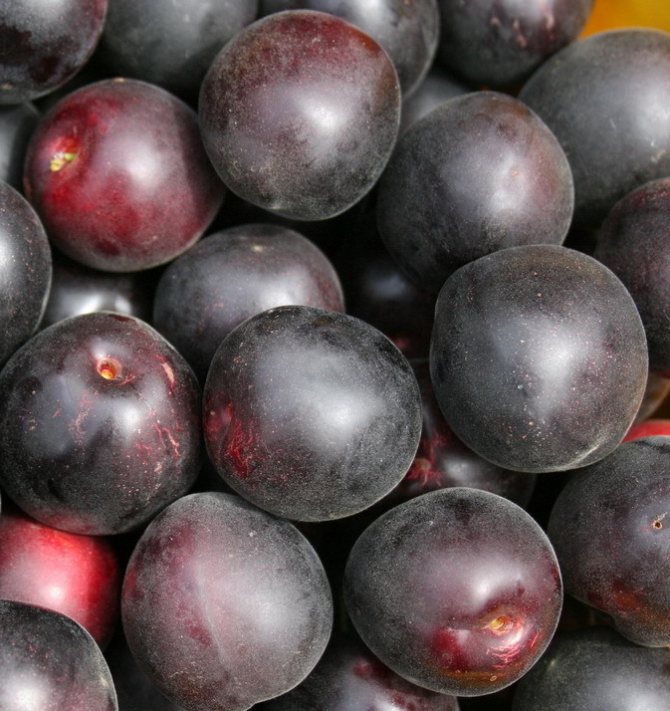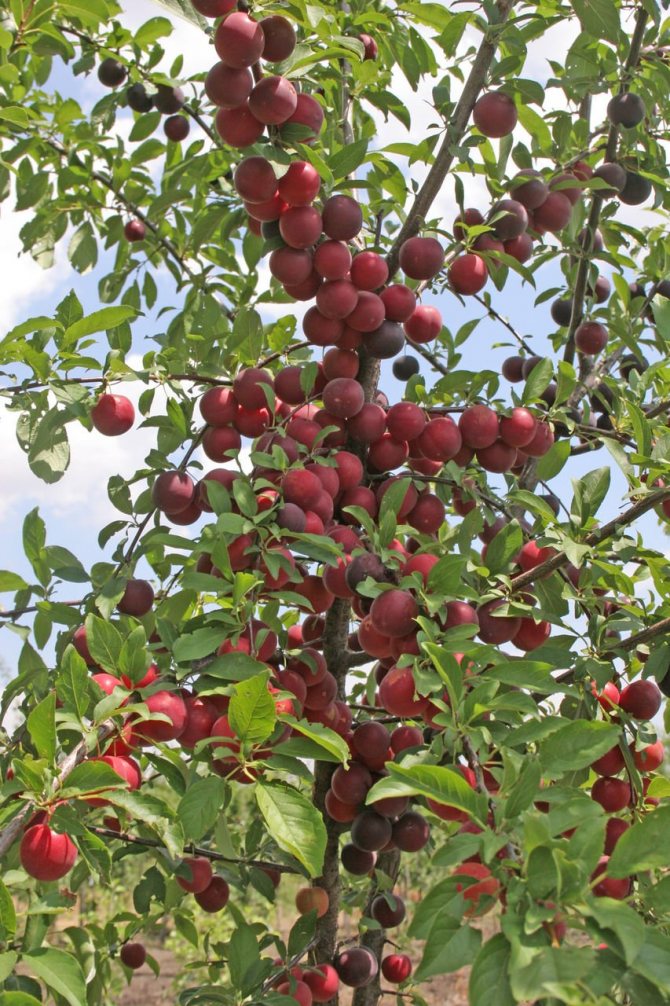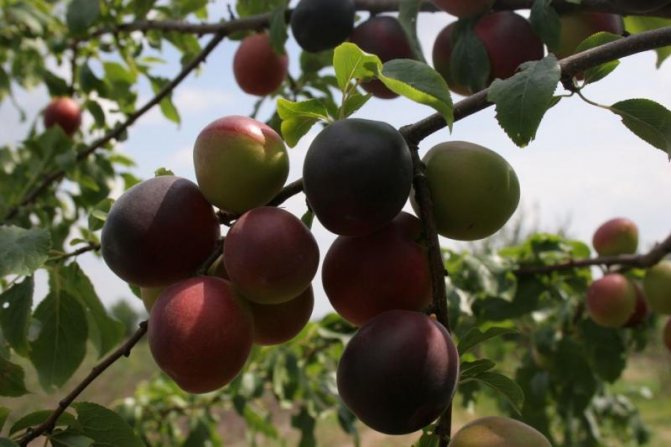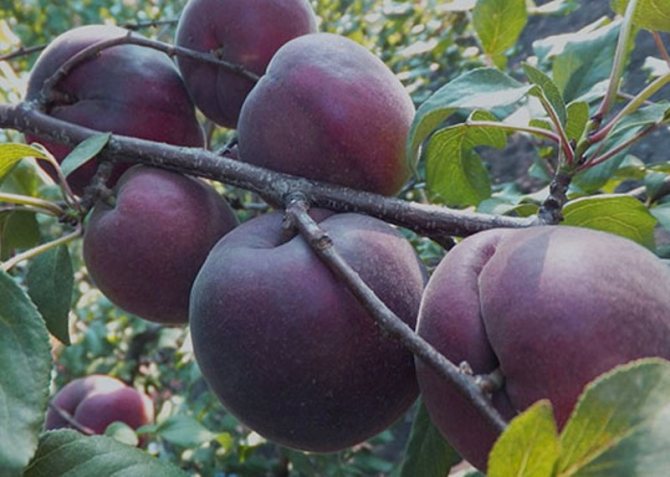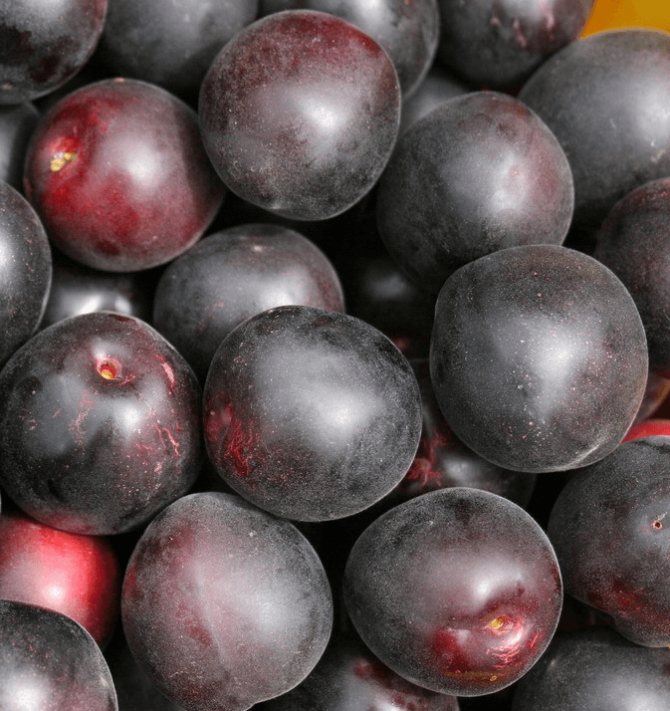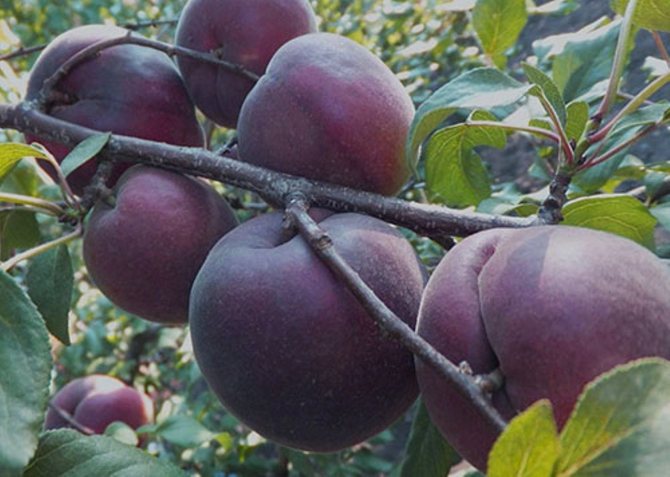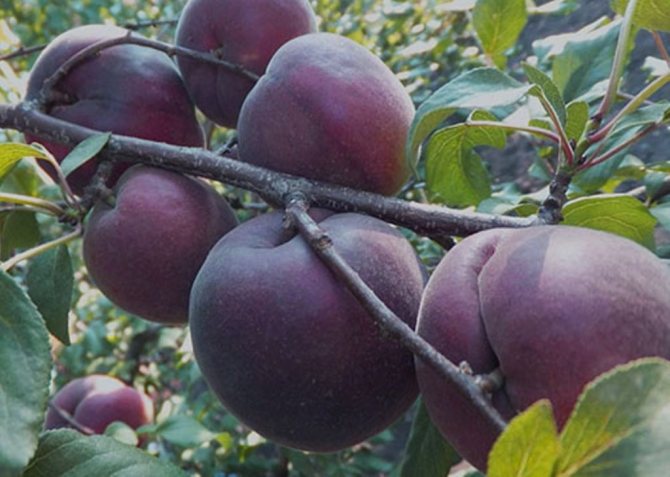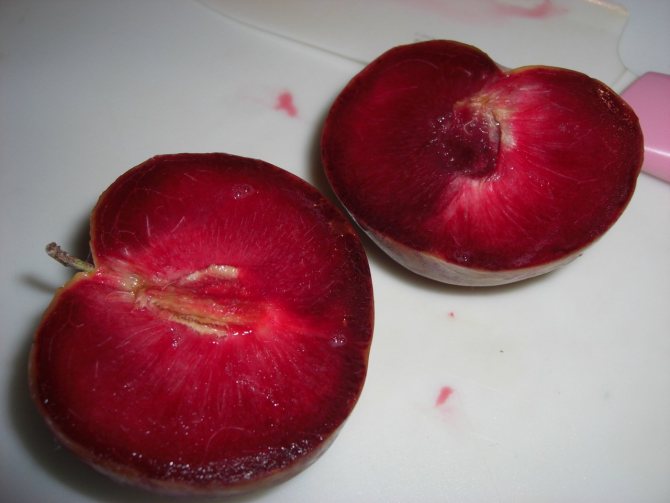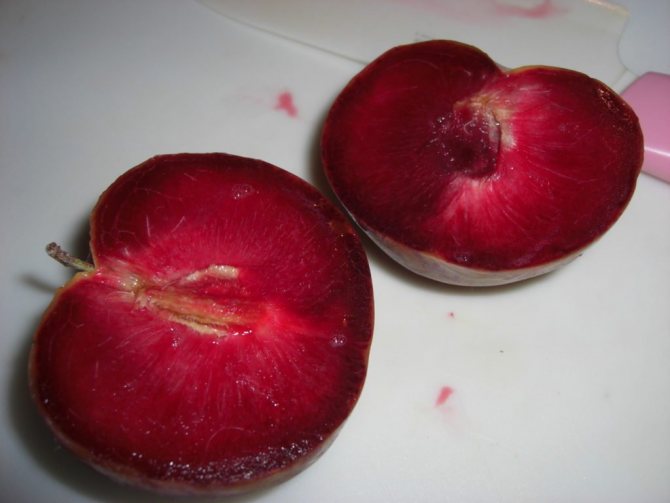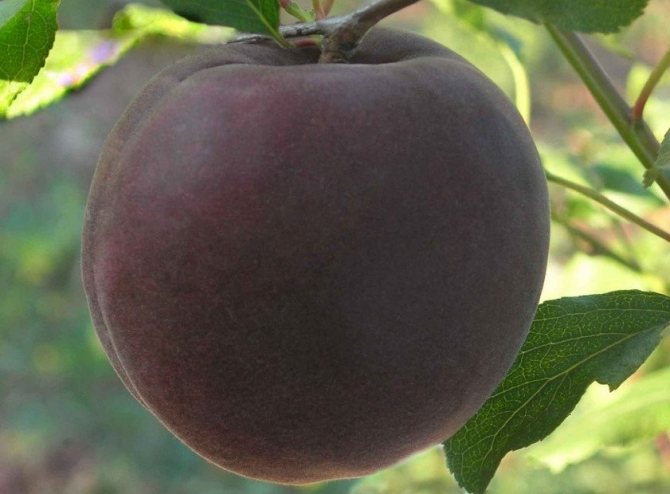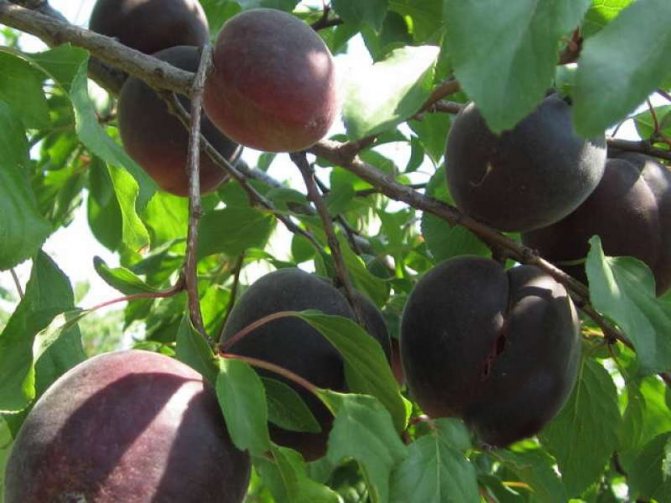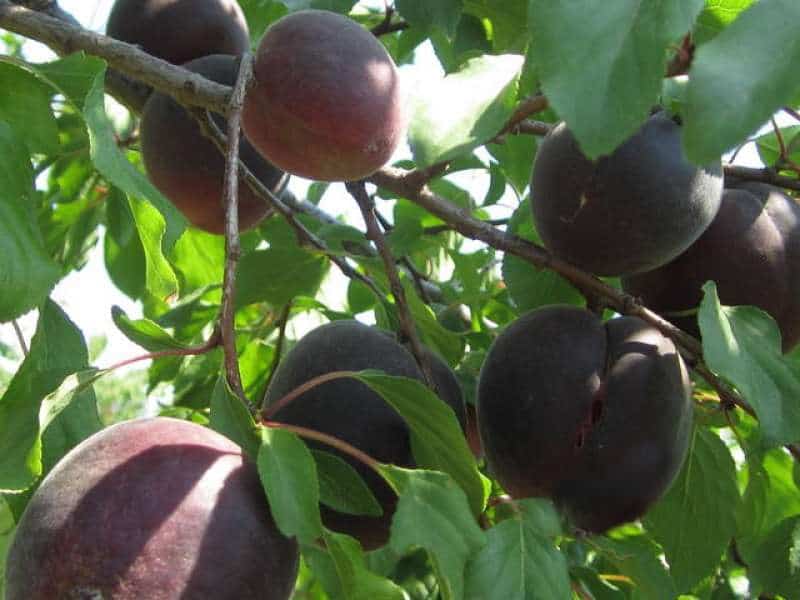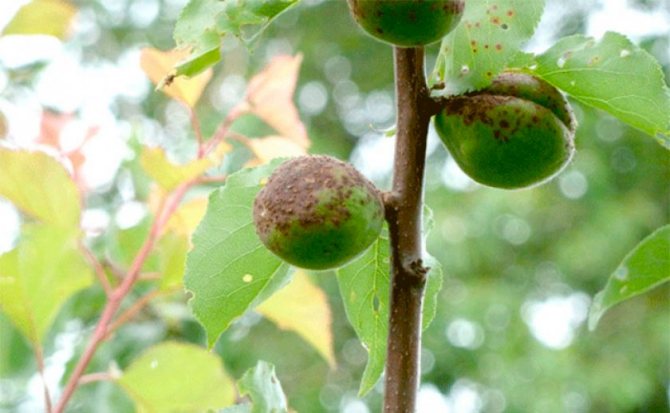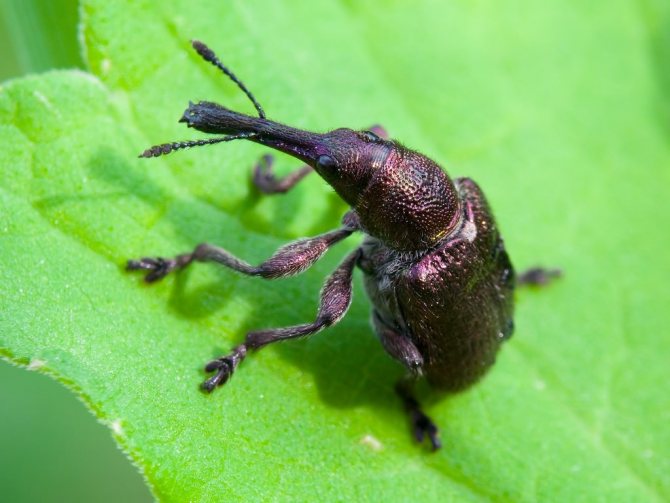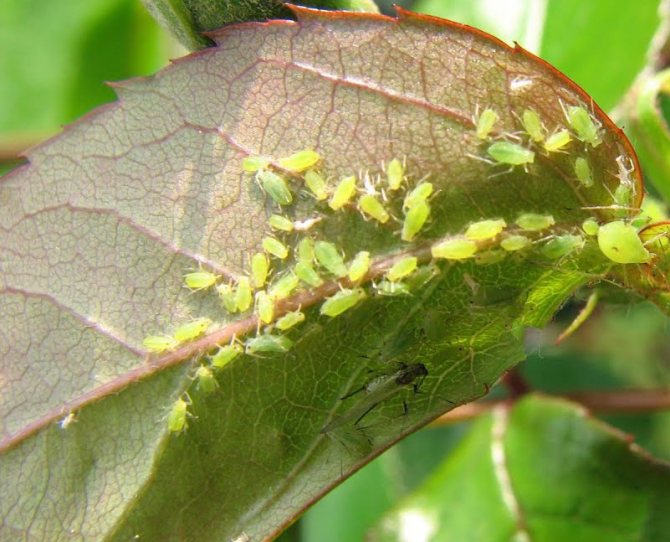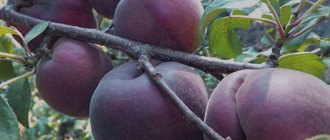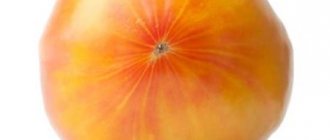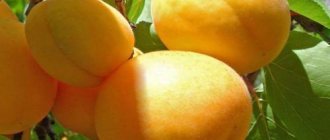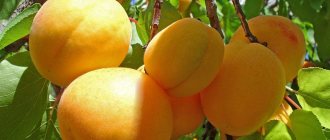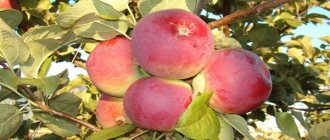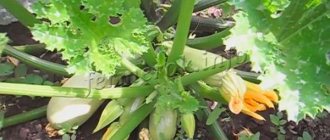"Black velvet": variety description
The unusual apricot of the Black Velvet variety was born thanks to the efforts of the Crimean breeders, who crossed the American Black variety with the usual cherry plum. As a result, it was possible to obtain a medium-sized tree, which begins to actively bear fruit in the third or fourth year after planting. The crown is flat, has a rounded shape and is medium thick.
Choosing the Black Velvet variety for growing in your garden, you should also be aware of its partial self-fertility. This means that to get a good harvest, it is better to plant other varieties of apricots nearby. As for endurance under unfavorable conditions, the black apricot copes well enough (in comparison with other varieties) with winter frosts, has an average level of drought resistance and is able to withstand many diseases.
Main advantages
- Due to the later flowering (compared to other stone fruits) of this variety of black-fruited apricots, neither late nor recurrent frosts are terrible.
- The compactness of the tree makes it easy to care for.
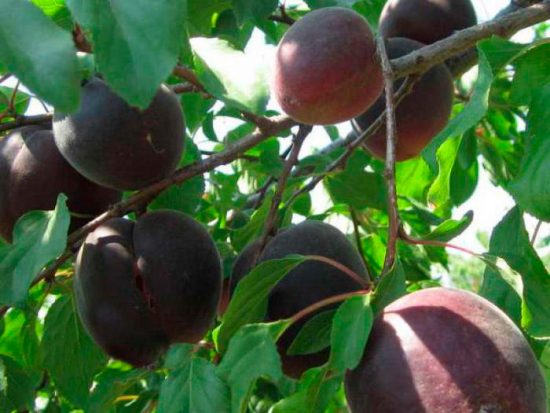
- This variety is much more resistant to disease.
- It is versatile in use - only such apricot can be eaten fresh with pleasure, and not only in compotes, preserves or jam.
- Among its own kind, it has the highest yield.
- There are no problems with pollination - there are enough related crops in the garden: apricots, plums, cherry plums.
Conditions for growing black apricot
As with the cultivation of any other variety of apricot, in order to properly plant the "Black Velvet", first you need to understand its preferences in terms of illumination and soil composition.
Where is the best place to plant Black Velvet, lighting
Representatives of the described variety, like the rest of the apricots, will be able to actively grow and bear fruit only in well-lit places. That is, before landing, you will have to determine the warmest and sunniest place on the site
... Failure to comply with this requirement will lead to a decrease in the sugar content of the fruits and a decrease in the total amount of the crop.
At the same time, apricot cannot be called a frost-resistant crop, therefore do not forget about protecting the place from the north and east winds... In order for the Black Velvet apricot to grow and develop well, it is better to plant it next to a house or other buildings on your site (for example, near a barn, a bathhouse, or between a house and a fence).
Also, when choosing a place, remember that the apricot, in principle, does not like stagnant water in the soil, so if there is a high probability of flooding in your area, then, if possible, it is necessary to drain or plant a tree on a hill. Otherwise, the plant will develop poorly or will soon die. The groundwater level should be at least 1.5-2 meters to the soil surface.
Soil for growing black apricot
The second, no less important issue when choosing a place for growing apricot varieties "Black Velvet" is the composition of the soil at the place of planting, which will also determine the characteristics of planting and further care of the tree. Apricot thrives best on light loamy or sandy loamy soils, while heavy clayey or sandy soils most likely will not be able to ensure proper development of the tree.
How to choose a place and plant it correctly
For planting an apricot, it is necessary not only to find a suitable place and to prepare the planting pit in advance. The speed of development of the tree, as well as the time and financial expenses for care, depends on the correctness of the pre-planting preparation.
Apricot is a light-loving and heat-loving culture. Therefore, a plot is selected for it on the south side with free access to daylight and sunlight.
To prevent damage to the tree by low temperatures, it is better to plant the apricot near the walls of the house or outbuilding.
Fruiting apricot
Young and adult apricot tree does not tolerate waterlogging. The groundwater level should be no closer than 2.3 m. Therefore, it is absolutely impossible to plant it in the lowlands. Also, when planting, be sure to provide good drainage.
Apricot grows well on light loam and loam. The soil should not be heavy, clayey or sandy. Soil acidity within pH 7.
When choosing a suitable place for an apricot, it should be borne in mind that the tree does not tolerate transplanting well. Therefore, the planting site must be a permanent habitat.
Planting an apricot seedling with an open root system in the ground is carried out only in early spring. Plants in containers can be planted from early spring to the second decade of October.
If the planting of the apricot Black Velvet is planned in advance, a planting pit is prepared in the fall. For this, a pit is dug with a diameter of 0.8 m and a depth of 1.0 m.
A drainage layer of stone, broken brick and large branches is laid at the bottom. Then the soil is mixed with humus or humus in the amount of 20 kg. All the resulting mixture is poured back into the pit.
After planting the seedling, the soil is slightly compacted in the hole. The tree is watered with a bucket of water, and the near-trunk area is mulched with sawdust or clean soil.
For fast rooting, it is recommended to treat the roots of the seedling with a special stimulant. This will allow the plant to better tolerate the change of place of growth and adapt to new climatic conditions.
Basic rules for planting "Black Velvet"
The process of planting "Black Velvet" can be divided into two main stages: preparation of the pit and the direct placement of an apricot seedling in it. In both cases, there are specific features that cannot be ignored to obtain a fruitful apricot.
Important nuances when preparing a landing pit
To plant medium-sized varieties, which include "Black Velvet", it is necessary to dig a hole 60 x 60 x 70 in advance, then place a drainage layer on the bottom (for example, from gravel) and lay out fertilizer (horse humus or humus in combination with potassium chloride - 20 g and superphosphate - 30-40 g).
How to properly plant a "Black Velvet" seedling
What you need to know about caring for an outlandish apricot
Like the usual yellow apricot, its black variety needs proper and timely care. That is, you are required to regularly water using a sufficient amount of water, feed the plant and follow the rules for pruning. It is also important to know how the apricot tree is pollinated because partial self-fertility of the Black Velvet variety may require manual pollination.
Watering frequency
Plant feeding
How to prune a black apricot correctly
Apricot varieties "Black Velvet" are prone to the formation of root growth, which requires its regular pruning (excess shoots are cut out near the ground, since they consume a large amount of nutrients, and the yield is almost always very low). As for the branches, when buying a young seedling, they are cut by almost a third, which contributes to the quick establishment of the crown.
It is worth remembering that apricot often grows faster than other trees in the garden, which means that with normal development it will have to be cut more than others, which is especially true for a later age.
With a reduced growth, the branch is cut to older wood (by 2-3 years).
It is important to perform the pruning procedure every year in early spring (before bud break). It is highly undesirable to prune branches in late autumn.
If a full branch is cut, the cut must be carried out at the very base (the so-called "cut per ring"), without leaving any stumps.
In the case when the Black Velvet apricot grows too intensively, young strong shoots are pruned at the end of summer (cut about 10-15 cm). This helps the branches begin preparing for winter (they thicken).
Read also: We grow the Orlik apple tree in our garden


Harvesting and storage
It is necessary to pick fruits 2-3 days before full ripening, since fully ripened fruits are poorly stored and transported, and besides, they begin to crumble. Crashed when dropped, they are unsuitable for long-term storage in the open air and without heat treatment. In a slightly unripe apricot of the Black Prince variety, the stone is better separated.
If long-distance transportation of the apricot crop is planned, the fruits are harvested unripe. In crates and boxes, they will easily reach the required maturity.
Also, preserves, jams, marmalades, nectars and various desserts are prepared from apricots. Fruits are frozen, dried, boiled and canned.
"Black velvet": advantages and disadvantages of the variety
Apricot "Black Velvet", despite its exotic and unusual appearance, has not yet achieved universal love and recognition from gardeners. However, in fact, this variety has a number of advantages that distinguish it from other varietal varieties of apricot.
The main ones include:
It should also be noted that the black apricot is more resistant to disease and frost (especially to recurrent cold snaps at the end of winter) than its yellow brother. So, this variety is much less likely to affect moniliosis, clasterosporium and cytosporosis, which has a positive effect on the regularity of its fruiting. "Black Velvet" can be planted in regions with a more severe climate (for example, in the middle lane, up to Moscow or the Volga region).
The relative disadvantages of the Black Velvet cultivar are the small size of the fruits and poor pollination of the apricots (the cultivar is partially self-fertile). In the latter case, you will need information on how to manually pollinate an apricot.
As you can see, it cannot be argued that apricot "Black Velvet" is devoid of drawbacks in cultivation, however, a large number of its positive characteristics still dispose to its cultivation on its site.
Pros and cons
Many summer residents, who planted the Black Prince and harvested the first harvest, were satisfied with the varietal characteristics of the apricot. But before choosing a crop for your garden, you need to know about all the pros and cons of the variety.
The benefits include:
- The variety is unpretentious in care and planting;
- He has excellent frost resistance, withstands the winters of the middle zone;
- The fruits are large;
- Pleasant taste;
- High resistance to diseases such as: moniliosis, clasterosporium disease;
- Excellent decorative qualities in spring during flowering and in summer when fruits are ripe;
- Due to late flowering, flowers and ovaries do not die due to returned spring frosts.
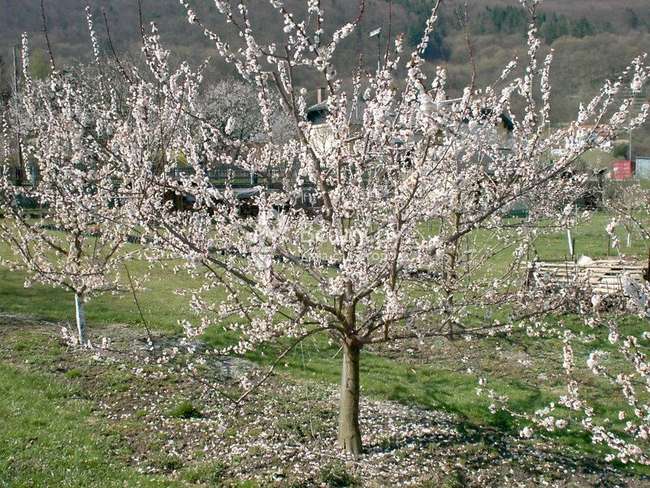

The flowers on the apricot resemble snow.
But it is worth taking into account a number of disadvantages:
- Poor transportability. The fruits quickly crumple, spoil, do not lie.
- Overripe apricots have cracked skin.
- Despite the winter hardiness, the plant must be covered and mulched for the winter.
- In the sixth year of growth, thorns appear, which complicate the collection and cultivation of the variety in the garden.
Breeding history
The Black Velvet Hybrid is actually not quite an apricot. It was obtained by crossing American black apricot and cherry plum. The slow pace of development in spring and the late flowering time he inherited from the latter, contribute to stable yields, since they naturally protect the tree from spring frosts. Black Velvet took over the taste and aroma of the fruit from the apricot.
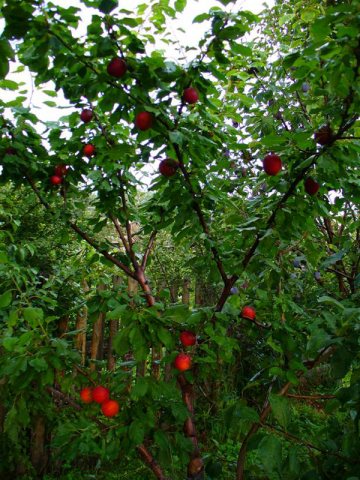

The merit of the birth of this variety belongs to G.V. Eremin and A.V. Isachkin - researchers of the Crimean Experimental Breeding Station of VNIIR named after V.I. N. I. Vavilova (Russia, Krasnodar Territory). The apricot variety Black Velvet was identified by them in 1994.
In 2005, he was included in the lists of the State Register.
Description of culture
The description and photo of the apricot Black Velvet clearly explain why the people like to call this hybrid "apricot". The tree is characterized by medium growth (no higher than 4 m), round, slightly flattened crown of medium density.
The leaves of its rich green color, medium, have an elongated shape and pointed ends. The flowers are large, white or pale pink.
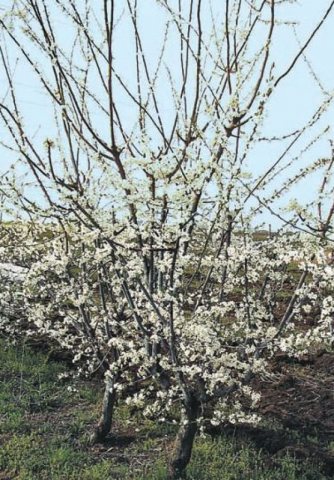

The fruits of this variety are multiple, but smaller than those of most common apricots. Their average weight is 25–35 g, the shape is oval, a sharp "nose" is noticeable near the stalk. The skin is of medium thickness, slightly pubescent. In unripe fruits, it is green in color, then it acquires a rich brown or dark purple color.
An interesting characteristic of the Black Velvet apricot variety is an unusual, two-colored fruit pulp. Near the stone, it is bright yellow, but closer to the skin it becomes pinkish.


The taste of the fruit is pleasant, sweet with a noticeable sourness, slightly tart, with a bright aroma inherent in apricot. The bone is small. It separates from dense, juicy, slightly fibrous pulp without much effort.
Initially, the variety was zoned for the North Caucasian region, but it grows quite successfully in central Russia, which has a temperate climate.
A general idea of black apricot will help you compose a video:
Testimonials
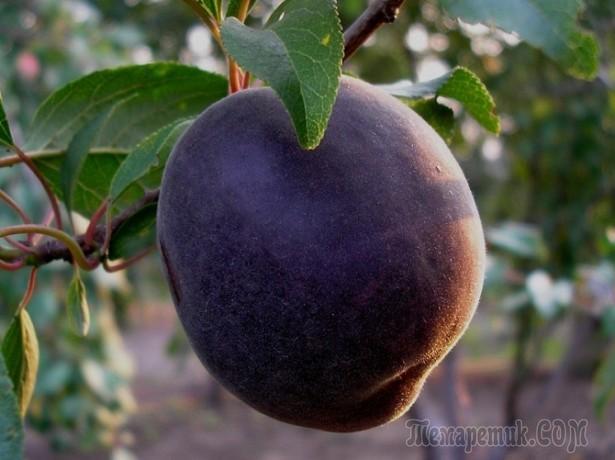

Black-fruited apricot varieties are still not widespread in the gardens of Central Russia, although they are no longer a novelty in the Crimea, the North Caucasus and the Kuban. Someone is stopped by a lack of information and the risk of buying a "pig in a poke" from an unscrupulous seller. And if it is not difficult to find out more about this wonderful variety, then difficulties may arise with the purchase of a seedling of this particular plant.
This is not to say that black apricot grows in every garden, but recently the demand for a hardy extraordinary hybrid has begun to increase. The black prince is advantageously distinguished by its large-fruited and high taste among his fellows. Its frost resistance is not as high as that of other black-fruited varieties, but it is quite enough to grow an apricot in the zone of risky farming.
Marina Pavlovna. Volgograd.
I have been growing apricots Black Prince for 5 years. I really like ripe fruits, juicy, large, with a pleasant aftertaste of peach and plum. The trees are completely unpretentious. The only care, sometimes feeding and harvesting.
Inga Viktorovna. Tyumen.
Although it is not customary for us to grow apricots because of the cold climate, I tried to plant seedlings 4 years ago. She did not regret her deed for a single day. In September, we collect tasty, juicy, aromatic and healthy fruits, which we not only eat raw, but also make numerous preserves of jam, juice and even fruit puree. For the winter, we cut the trees and insulate them well.
Vitaly Dmitrievich. Shatura.
We bought the black prince saplings because of their disease resistance. And it is true.Last year, other fruit trees on the site were sick, and the apricot was not affected at all. From ripe fruits we cook compotes, jam and make freezes.
Black apricot has undoubted advantages and deserves the attention of gardeners. If the first varieties are far from perfect, now the gardener already has plenty to choose from. Unpretentiousness and ease of care are captivating, allowing even a beginner to grow an unusual berry.
Black apricot is not so exotic for Russian gardeners. Dozens of varieties have been bred and successfully grown. The fruits ripen in the conditions of the Moscow region, the Volga region and even Siberia. Simultaneously with the popularization of culture, its selection continues.
Characteristics
Thanks to the painstaking work of breeders, the Black Velvet variety managed to embody many of the strong qualities of both apricot and cherry plum.
Drought resistance, winter hardiness
The indicators of winter hardiness and resistance to low temperatures in Black Barakhat are high - in this it is not inferior to frost-resistant varieties of cherry plum. The flowers of this black apricot variety are practically not afraid of recurrent spring frosts.
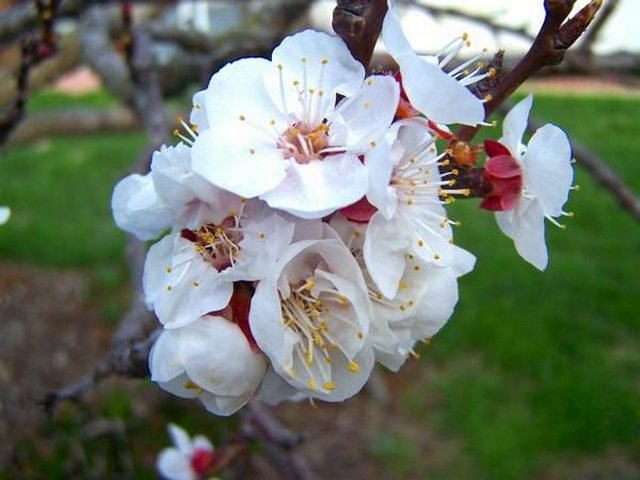

The summer drought tolerance of Black Velvet is lower than that of common apricots.
The ideal conditions for a stable, regular harvest from a tree of this variety are warm, sunny and low wind summers.
Pollination, flowering period and ripening times
Black Velvet belongs to the partially self-fertile apricot varieties. In order for the yield to be higher, it is recommended to plant potential pollinators near the tree, blooming with it at the same time:
- common apricot;
- plum (Russian or Chinese);
- turn;
- cherry plum.
Black Velvet blooms later than other varieties of apricots. Its fruits ripen by the end of July (in the south) and at the beginning of August (in the middle lane).
Productivity, fruiting
Black Velvet has a medium early maturity. It usually takes 3-4 years from planting a grafted seedling in the ground to collecting the first fruits.
This variety is recognized as high-yielding: one tree is capable of producing 50-60 kg of fruit per season. It bears fruit regularly, almost every year.
The Black Velvet crop is excellently transported and stored. Slightly unripe fruits, laid in boxes in 2-3 rows in a well-ventilated cellar, are quite capable of lying there for 3-4 months.
Read also: Why is the Isabella grape variety useful?
Scope of the fruit
The purpose of the Black Velvet fruit is universal. They are eaten fresh, frozen for future use, used in the preparation of sweet desserts. Jam and jam from the fruits of this variety favorably differ in excellent taste with tart notes and bright, rich color.
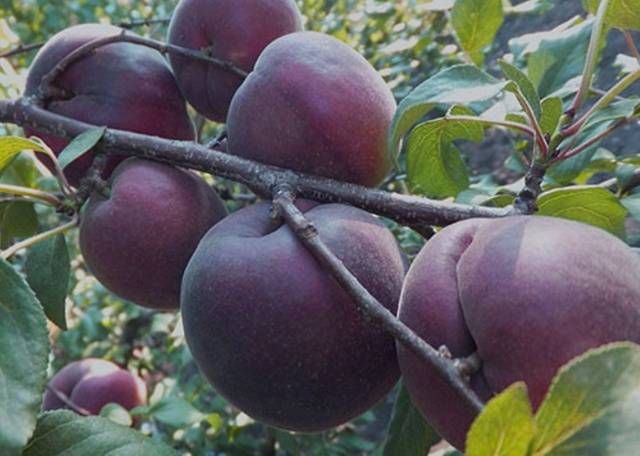

Disease and pest resistance
Black Velvet, like most dark-fruited apricot hybrids, has an increased resistance to moniliosis, clasterosporium and cytosporosis, which traditionally affect stone fruit crops.
Advantages and disadvantages
The advantages and disadvantages of apricot Black Velvet can be briefly described as follows:
Preparing for winter
We must not forget that apricot is a southern culture, which means it is thermophilic. Although the Black Prince variety differs from its relatives in its increased resistance to negative temperatures, winters of temperate and northern latitudes, it is difficult for them to survive. Therefore, trees are prepared for hibernation in advance.
- The trunk circle is cleaned of dried leaves and insulated with a thick layer of humus.
- The barrel is treated with a solution of lime or chalk with copper sulfate and ordinary office glue. Such an event will protect the tree trunk from the encroachments of rodents and small animals.
- Young seedlings are completely covered with special materials, burlap or wooden boxes.
Important! For warming plants, it is forbidden to use synthetic materials that are impervious to air and moisture.
The history of the origin of the variety
Somewhere (in South or Central Asia), once (at the beginning of the last century), someone (who exactly - we will no longer know) planted in the ground a stone of an accidentally grown apricot of an unusual black color. The fruit grew as a result of spontaneous cross-pollination of two trees - apricot and cherry plum, its taste was rather mediocre. But breeders became interested in him precisely because of the unusual color. This opened a new niche in the fruit market, and work on obtaining new varieties of black apricots began.
The breeders were faced with the task of improving the taste of the fruits and increasing the winter hardiness of the culture. At first, the black apricot was distributed where it originated - in Asian countries, then in America. Quite a few varieties have been produced. In Russia, the selection of this culture was carried out at the Crimean Experimental Breeding Station (the city of Krymsk, Krasnodar Territory). There, the Black Velvet variety was allocated in 1994, and in 2005 it was included in the State Register for the North Caucasus region.


In Russia, the selection of apricot Black Velvet was carried out at the Crimean Experimental Breeding Station in the Krasnodar Territory.
Apricot "Black Prince": what a tree and a fruit look like
The "Black Prince" apricot is described as a small tree or a tall shrub.
He has a narrow and not too thickened crown, skeletal structure of branches, which may have thorns. The bark of the tree casts a dark green tint. The foliage on a short and thin petiole is more often oval, the edges of the leaf blades with teeth.
The "Black Prince" blooms with white or light pink flowers. The fruits ripen in August, depending on the region, at the beginning, middle or at the end of the month. A hybrid of apricot and plum "Black Prince" is not the only variety of black apricots, but differs from other varieties in the largest fruits.
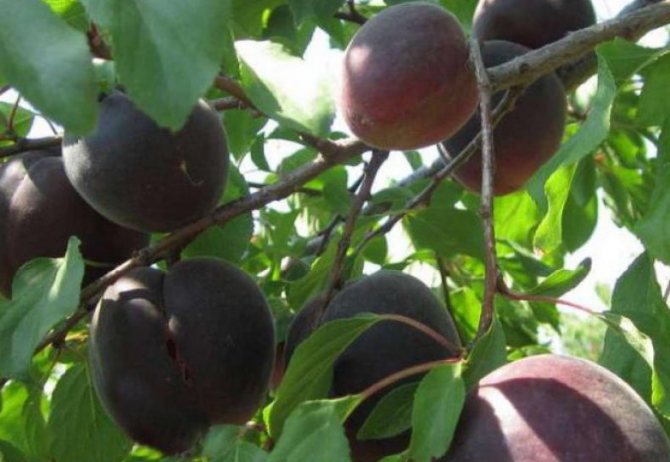

In regions with a temperate climate, the weight of the fruit is 45-60 grams, in the southern regions it reaches 90 grams of weight. The skin of the fruit is dark burgundy, the flesh is often wine red, juicy and loose. The bone is easy to separate from the pulp, it is small in size. The taste of this hybrid is pleasantly refreshing, tart with sourness. The pollinator for black apricot can be apricot, plum, cherry-plum, blackthorn and other varieties of black apricots, although the crop is self-pollinated.
We recommend to read: Circulation pumps for home heating systems: calculation, selection, diagram
Description and characteristics of apricot Black velvet
It is a small tree with a rounded, spreading, medium thickened crown. The early maturity of the variety (the period from planting a seedling to the first harvest) is average - 3-4 years. Self-fertility is partial, it needs pollinators, which can be varieties of cherry plum, plum and blackthorn, blooming at the same time as Black Velvet. Ripening of berries occurs in the second decade of July in the southern regions, in the first decade of August - in more northern regions. The taste is good, sweet and sour.
Apricot Black velvet has its own advantages and disadvantages.
- high winter hardiness of both wood and flower buds - Black Velvet flowers tolerate return frosts well, and natural stratification (hardening) even increases productivity;
- high immunity to fungal diseases - much better than that of their yellow-orange counterparts.
- blooms and bears fruit later than ordinary apricots, although this is at the same time an advantage - after all, flowers, as indicated above, are not afraid of recurrent frosts;
- drought resistance is lower than that of ordinary apricots;
- the stone is small and does not separate well - this property went to Black Velvet from cherry plum.


Apricot varieties Black Velvet blooms much later than usual varieties
Fruits are round-oval, small (average weight - 24 grams, and according to the All-Russian Scientific Research Institute for Breeding of Fruit Crops (VNIISPK) - 30 grams), slightly pubescent, velvety to the touch.Skin color - from dark red to dark purple, red pulp (according to the description of VNIISPK - yellow), dense, fibrous, juicy.
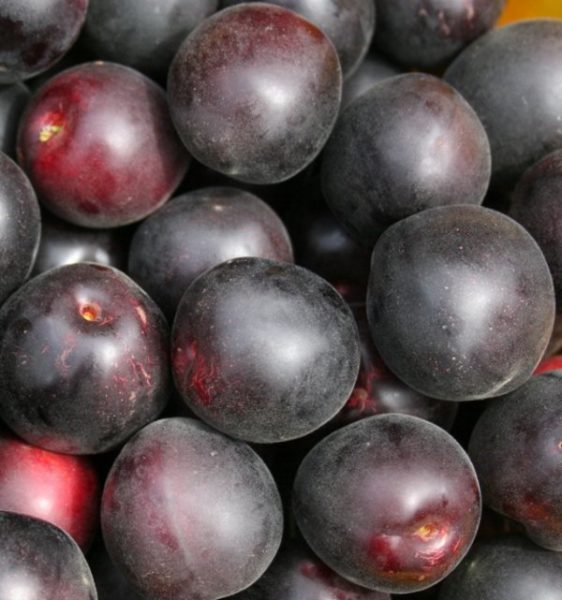

Apricot fruit Black velvet has a velvety, dark purple skin
The purpose of the fruits is universal, transportability and keeping quality are good. Packed in 2–3 rows in ventilated boxes, they can be stored in the basement for 3–4 months.
Landing specifics
In order for the apricot to bear fruit well and give high yields, you need to properly plant a young seedling. The future health and fruiting of the tree depends on this procedure.


Optimal timing
Planting a seedling is carried out in early spring or autumn. For more northern regions, it is recommended to carry out work in the spring, so that by autumn the apricot can take root well and get stronger. For the south, planting dates are wide. In such conditions, Black Velvet takes root well.
Choosing the right bush
Young trees are purchased in specialized stores and proven nurseries. Pay attention to the condition:
- foliage (healthy, no signs of disease);
- roots (no rot);
- bark (no chips, cracks, scratches, damages).
Important! It is recommended to take 1-year-old seedlings, they take root faster and easier.
Favorable and unwanted neighbors
Apricot is an exotic plant, therefore it does not live well in the neighborhood with the plants familiar to the region. He does not love:
- apple trees;
- pears;
- plums;
- peach;
- cherries;
- red rowan;
- cherries;
- nuts.
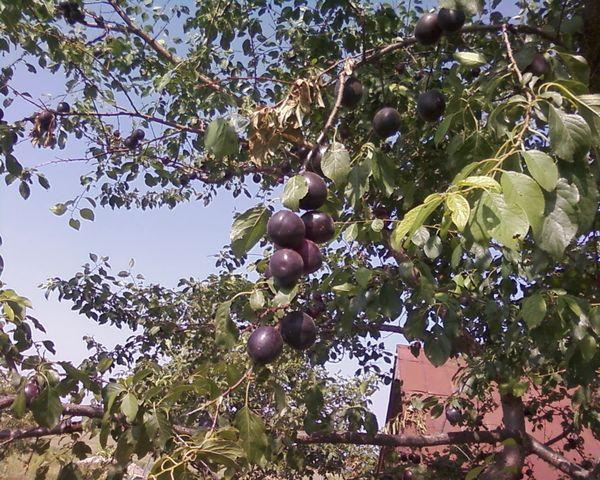

Also, do not plant shrubs under the tree. They intertwine with the root system of the tree and interfere with normal nutrition and mineral metabolism. Good neighbors for apricot are:
- cherry plum;
- other varieties of apricots;
- quince;
- barberry;
- hawthorn.
Seedling preparation
The seedlings are prepared in advance. The roots of a young tree are soaked in a weak solution of potassium permanganate for a day. Do not leave the roots uncovered, if they dry out, the tree will die. When buying an apricot in the fall, planting can be postponed to spring. To do this, the seedling is buried in the ground at an angle, left in a greenhouse, and covered for the winter.
Planting technology
Planting work is carried out in several stages:
- Choose a sunny place on the north side, protected from the wind.
- Dig a hole with a depth and diameter of about 1 m.
- The excavated soil is mixed with humus and mineral fertilizers.
- Half of the mixture is placed back in the pit, left for 2 weeks.
- The seedling is placed in the center of the hole, the roots are straightened.
- Cover with soil layer by layer, compacting each.
- A near-trunk circle is formed with a diameter of 50 cm, a depth of 7-10 cm.
- Sprinkle abundantly with water.
See also
Description of the 11 best varieties of apricot for growing in Siberia, the subtleties of planting and care
To read
It is recommended to choose areas where groundwater is at a depth of no more than 1.5 m.
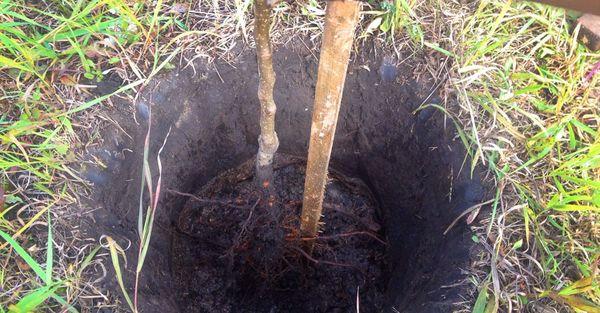

Growing features
Cultivation of apricot Black velvet requires the usual agronomic methods and techniques for this crop. We will describe them briefly for a novice gardener.
Black velvet is planted in early spring - before the start of sap flow - with a one- or two-year-old seedling purchased in the fall and stored until spring in the basement or dug in the garden. Procedure:
- The planting pit is prepared in the fall, filling with a nutrient mixture of equal parts of humus, peat, black soil and sand, with the addition of 3-4 liters of wood ash and 300-400 g of superphosphate.
- The root collar is left at the soil level.
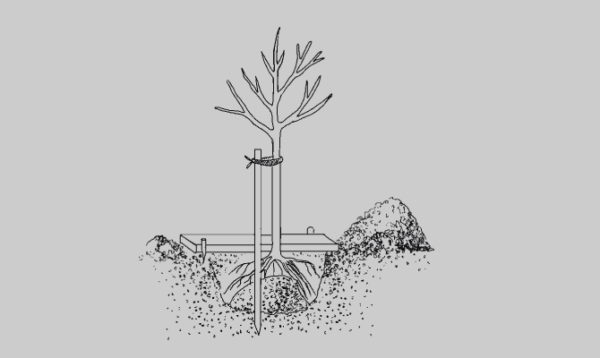

The root collar of the apricot seedling should be at soil level
Standard care measures ensure the viability of the seedling.
Apricot Black Velvet is rarely watered, but abundantly, providing soil moisture to a depth of 30-40 centimeters:
- the first time - during flowering,
- the second - at the beginning of June,
- the third - after harvest,
- the fourth - in October-November.
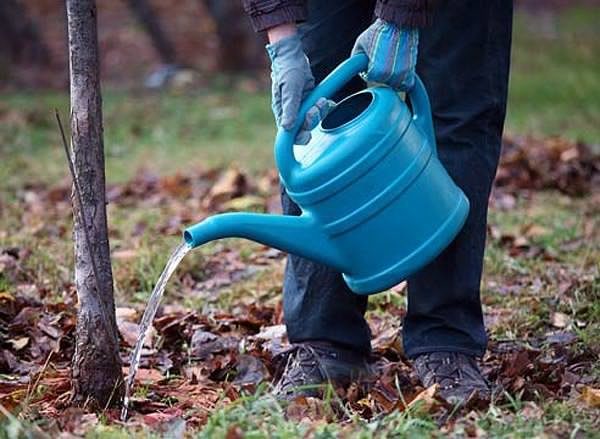

Apricot Black velvet should be watered rarely, but abundantly
The first time they feed the apricot tree after the first harvest.Then, every 3-4 years, organic fertilizers are applied for digging in autumn or spring. Mineral fertilizers are applied annually:
- nitrogen-containing - in the spring for digging;
- potassium-containing - in early June, together with watering, dissolving in water;
- phosphorus-containing - in October for digging;
- complex - according to the instructions.
Video: how to feed an apricot
Trimming the crown of an apricot takes place in several stages and depends on the age of the plant:
- In the first 4–5 years, the crown of a tree is formed in the shape of a "bowl". In the spring of the second year, all branches are shortened to a length of 5 cm from the trunk, as a result they branch out. In the third year, the procedure is repeated, as a result, the crown takes the shape of a bowl.
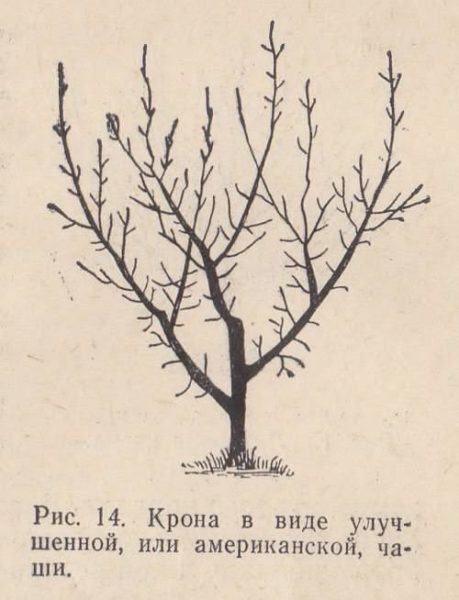

The improved, or American, bowl differs from the usual one in that the stem is lower, and the number of branches is less (three), as a result, the distance between them is greater, there is no thickening of the crown


Removal of apricot shoot tips to stop growth (minting) is carried out in summer
Video: pruning apricots in summer
Prevention of diseases and pests
The high resistance of the variety to fungal diseases, combined with regular sanitary and preventive measures, is almost guaranteed to save the gardener from trouble.
Disease and pest control
Prevention is the plant's best defense. For this:
- In the fall, the garden is cleared of leaves. This prevents the proliferation of pests. The foliage is burned and the ash is used as fertilizer.
- Sick and dried branches are removed, and the crown is also regularly thinned out. The procedure is carried out before the onset of cold weather or in early spring. The branches are burned.
- To protect the plant from pests, the trunk and large branches are whitewashed with special garden paints.
- To protect trees from rodents in winter, the trunks are wrapped with roofing material.
- Before the appearance of the first leaves, the tree is treated with a solution of copper sulfate.
- Protect the plant from insects with a trapping belt.
- It is treated with systemic fungicides to prevent fungal diseases.
If you follow simple recommendations, Black Velvet will delight you with an abundant harvest of tasty, juicy fruits.
Apricot Black Velvet: an amazing variety


The word apricot is usually associated with a large, orange or orange-red, juicy berry. Few have heard of black apricot. Even fewer have seen and tasted it. What is this miracle, where to see it, is it possible to grow on your site. Features of planting and growing. Basic rules of care. How can he get sick and what pests can be expected. How to deal with them. All of this below.
Description of the variety
The variety was obtained in Crimea by free pollination of American black apricot and entered into the State Register in 2006 for the North Caucasus region.
The tree turned out to be not too tall, the crown is of medium density, flat-round, spreading. It grows very slowly, the average growth per season is only 15–20 cm.
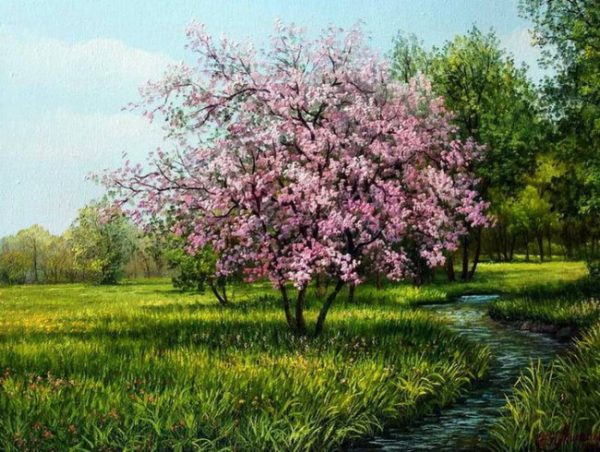

Apricot Black velvet blooms late, so it is not afraid of return frosts
It has excellent resistance to winter frosts, and the flowers tolerate recurrent frosts well, and do not fall off in case of a change in weather. Surprisingly, the yield even increases in such cases.
Unlike frost resistance, drought resistance is average, therefore it requires watering.
Black velvet is partially self-fertile, so it is good to have pollinators in the neighborhood to increase yields. Cherry plum, plum, turnip can act in their role.
After 3-4 years, after planting, you can expect the first berries.
In the southern regions, the harvest ripens in mid-July, further north - in early August.
The fruits of the Black Velvet are larger than the cherry plum berries, but smaller than those of the apricot (25–35 g), round-oval and black-purple in color. The skin feels like velvet. The berry has a small, but poorly detachable bone. This quality went to the hybrid from cherry plum. The pulp is red, juicy, sweet-sour, very pleasant taste, has a light apricot aroma.
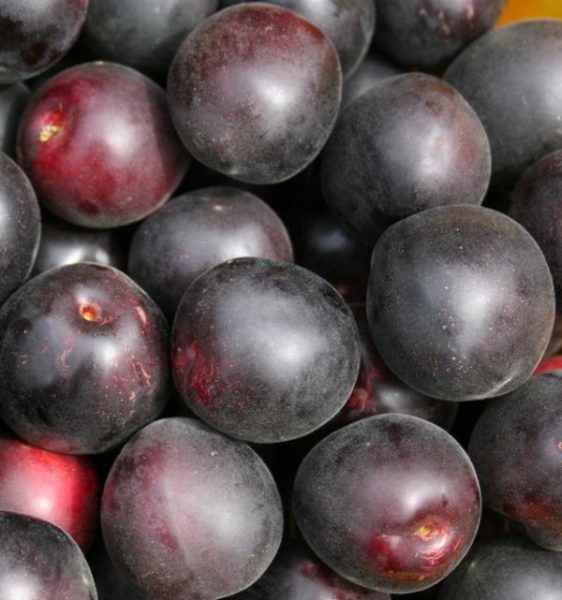

Apricot berries Black velvet of black-purple color, with a velvety skin
Good transportability. Harvested slightly unripe, berries can be stored in a ventilated basement for 3-4 months.
It has an important advantage - good resistance to the main types of fungal diseases.
Reproduction
Propagation of apricot is possible in two ways: by seeds and cuttings.
Seeds
The method is convenient for any time of the season. The seeds are soaked in water, dried for 2 days. Then they are placed in the ground to a depth of 10 cm, watered and await germination.
Cuttings
Cuttings are chosen with a diameter of at least 0.6 mm, a length of 15-20 cm. Then they are dipped into a root former solution for a day. Then they are placed in the ground and covered with a transparent cap. In this state, they are kept until rooting.
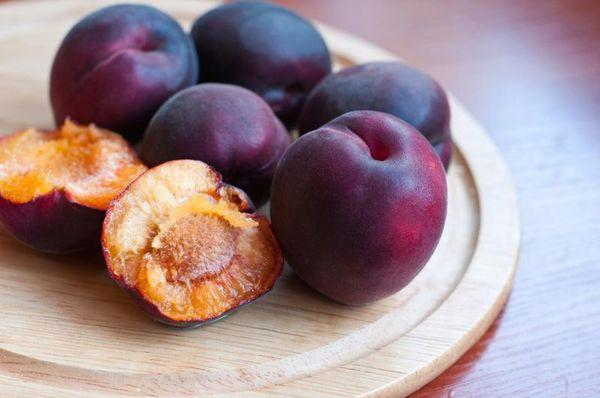

Planting apricot varieties Black Velvet
If a gardener wants to plant this apricot in his home in order to surprise neighbors and friends with an unusual berry in subsequent years, then first of all he needs to find a suitable place. Sheltered from cold northerly winds, well-lit place in the southern or southwestern part of the site, on a small slope - this is the best option for planting apricot Black Velvet.
In addition, the place should not be damp and the soil should not be acidic. In heavy soil, the apricot will grow, but it will not please with the harvest, so it is better to find a plot for it with looser soil.
And we must not forget about the neighbors, who pollinating the apricot, will contribute to the formation of a large number of ovaries, and, as a result, to obtain a high yield. If they are not there, then it is better not to plant partially self-fertile Black Velvet.
If the landing site is chosen, then you need to take several steps further.
If you bought an apricot seedling with a closed root system, in a bag or container, then you can plant it at any time from April to October. But don't keep it in a container unless absolutely necessary - the sooner it is in its permanent place, the better it will overwinter.
Care rules
This variety does not make high demands on the place of growth, but some conditions must be met.
In warm climates, apricot seedlings are planted in the spring, before the buds open, and in the fall - a month before the onset of frost. In colder areas, spring planting should be preferred. In the southern regions, the variety shows the maximum large-fruited. It can be grown even in the Urals and Siberia, but there you should take a responsible attitude to the wintering of the variety and its protection from frost. It is better for the black prince to avoid too rainy climates.
Did you know? Black apricots promote phlegm discharge, help with constipation, and are useful for metabolic disorders. They make delicious marshmallows.
The landing site should be sunny and calm. There should be no stagnant water or proximity to groundwater. Therefore, it is best to plant black apricots in high places.
The best soils are well-permeable fertile soils with a slightly alkaline reaction, but, in general, the variety is unpretentious to the quality of the soil. Acidic soil should be limed ahead of time. The variety will perfectly tolerate the proximity of plums, cherry plums or blackthorns. For one seedling, you will need to allocate 5 m² of land area.
The Black Prince variety belongs to the unpretentious species. How to care for him is described below.
This apricot is affected by diseases only under unfavorable conditions (rainy weather). To avoid this, it is enough to take simple preventive measures:
- collection and disposal of fallen fruits and leaves;
- weed control;
- processing of cuts when pruning with garden pitch;
- preventive spraying in spring with 2% Bordeaux liquid.
Insecticides such as "Aktara", "Iskra-Bio", "Tanrek", "Confidor" will help from pests (weevils, scale insects, moths). Lovers of organic farming can use a garlic soap solution.To prepare it, mince garlic, laundry soap and infuse in water in a ratio of 1: 1: 3. Then the resulting product is filtered and used for spraying.
Watering frequency
The variety does not like waterlogging, but it also does not tolerate a lack of moisture very well. Therefore, it must be watered regularly and often, but dosed and take into account the periods. During the spring growing season, he needs moderate watering. In the summer, a month before harvesting the fruits, moisturizing is done less often, and in the fall it is greatly reduced.
Did you know? Images of apricots dating back 6 thousand years have been found on drawings found on the territory of Armenia.
When watering, you should focus on the climatic conditions and weather in the region. During the rainy season, irrigation is stopped and more often the soil is loosened to evaporate excess moisture, and in arid regions, water-charging irrigation is done in the fall.
Feeding scheme
Apricot The Black Prince does not like excess nitrogen, so there is no need to get carried away with organic matter and nitrogen-containing fertilizers. The first two years are not fertilized. Subsequent years, in the spring, very moderately give organic matter or complex fertilizer with nitrogen at the rate of 35 g / 1 m². During the setting and growth of fruits, you should feed with potassium salt - 15 g / 10 l of water. Ash can be added, since it also contains a lot of this element.
Apricot Black Prince, as it grows, independently forms a rather rare crown, so there is no particular need for constant pruning. It is convenient to form the branches in the form of a bush at the level of human growth, as this facilitates the process of leaving. You can give the tree a cup-shaped or other tiered crown shape.
Formative pruning is carried out in early spring, before sap flow. To do this, the seedling is shortened by 1/3 and all vertical shoots are removed. As it grows, by pruning, the height of the tree is corrected by cutting off the conductor and branches growing upward. This allows the fruits to form on the side branches, which is much more convenient for harvesting apricots.
If necessary, do sanitary pruning of dry, broken and diseased branches. For this purpose, their removal is carried out not only in spring, but also in autumn, before the cold weather.
Preparing for winter
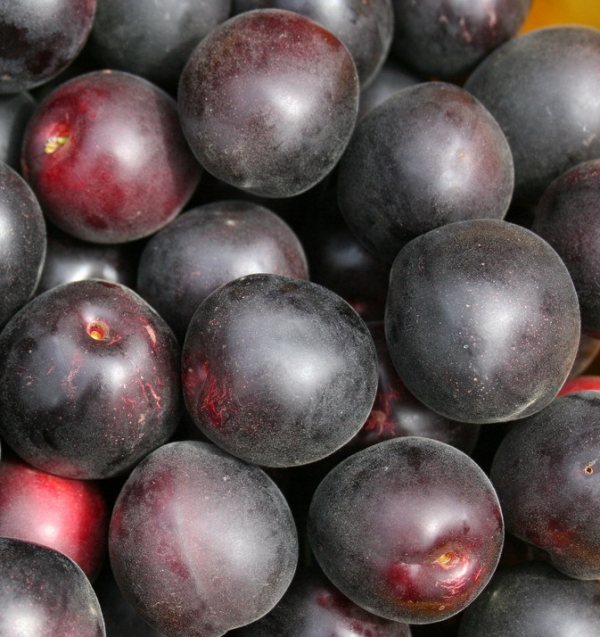

The Black Prince tree needs help to survive the cold, especially in the harsh winters. To do this, first clean the trunk circle and cover it with a thick layer of mulch. Then, the lower part of the trunk is whitewashed with a solution of slaked lime, into which it is recommended to add copper sulfate. A mound of about 30 cm is poured near the trunk. Young seedlings should be completely covered with cardboard boxes or wrapped in burlap, spunbond.
Important! For protection, breathable materials must be used, otherwise the apricot may begin to rot, which will lead to the inevitable death of the plant.
Natural immunity to diseases and pests, as well as the small size of the tree, simplify the care of the fruit crop. Timely watering, loosening the soil and top dressing will allow you to grow a healthy and fruitful plant.
During the period of growth and flowering, trees are watered abundantly and often. From the second half of summer, watering is gradually reduced so as not to cause active growth of young branches. After ripening and harvesting of fruits, irrigation activities are stopped altogether.
Important! Loosening the soil and mulching the tree trunk circle will help to enrich the roots of trees with oxygen and nutrients.
When forming ovaries, apricot needs additional nutrients. For this, fertilizing with a content of minerals and organics is suitable. Trees are fed no more than 2 times during the whole season. Nitrogen fertilizers and fertilizing are not used when growing a fruit crop.
Pruning
At the beginning of the spring, trees are pruned. Since the crown of the Black Prince apricot is not thick, it practically does not need formative pruning.
Pruning of trees is carried out before the onset of the growing season.After circumcision, the cut sites are treated with special antibacterial drugs or garden varnish.
Watering the black apricot should be done frequently, but not abundantly. Every two weeks, a bucket of water should be poured under the tree. It is best to do this in the early morning or evening, while making sure that the soil is not too wet. During the height of the hot season, spray the foliage of the tree with a spray bottle.
Pruning


Pruning is the crown formation required by the apricot. Since the tree is small, it will not be difficult to carry out the crown. Pruning provides good lighting, normal growth and increased yields. Sick and upright branches should be pruned: they do not yield crops.
Top dressing
Black apricot is fed twice a year:
- in the spring, ammonium fertilizers are applied (10–15 g of ammonium nitrate per 1 sq. m of the trunk circle);
- in the fall - phosphorus and potassium fertilizers (15 g of potassium chloride and 12 g of superphosphate per 1 square meter of the trunk circle).
Cracks in the trunk
The causes of cracks in the bore:
- temperature drops;
- waterlogging of the soil;
- too strong pruning;
- landing too deep;
- excessive feeding with nitrogen and organic fertilizers.
Cracks in and of themselves are not dangerous, but they are a great place to stay for bacteria, fungi, and a tree has a significantly increased chance of getting sick.
When a crack appears, take the following actions:
- We clean the black layer of wood to white with a knife or other sharp tool.
- We dilute a 1% solution of Bordeaux mixture and process the damaged bark, in this way we kill all bacteria.
- We process the crack surface with garden pitch.
- We wrap the wood in burlap to protect the treated surface.

